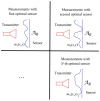On the Optimal Field Sensing in Near-Field Characterization
- PMID: 34209975
- PMCID: PMC8271742
- DOI: 10.3390/s21134460
On the Optimal Field Sensing in Near-Field Characterization
Abstract
We deal with the problem of characterizing a source or scatterer from electromagnetic radiated or scattered field measurements. The problem refers to the amplitude and phase measurements which has applications also to interferometric approaches at optical frequencies. From low frequencies (microwaves) to high frequencies or optics, application examples are near-field/far-field transformations, object restoration from measurements within a pupil, near-field THz imaging, optical coherence tomography and ptychography. When analyzing the transmitting-sensing system, we can define "optimal virtual" sensors by using the Singular Value Decomposition (SVD) approach which has been, since long time, recognized as the "optimal" tool to manage linear algebraic problems. The problem however emerges of discretizing the relevant singular functions, thus defining the field sampling. To this end, we have recently developed an approach based on the Singular Value Optimization (SVO) technique. To make the "virtual" sensors physically realizable, in this paper, two approaches are considered: casting the "virtual" field sensors into arrays reaching the same performance of the "virtual" ones; operating a segmentation of the receiver. Concerning the array case, two ways are followed: synthesize the array by a generalized Gaussian quadrature discretizing the linear reception functionals and use elementary sensors according to SVO. We show that SVO is "optimal" in the sense that it leads to the use of elementary, non-uniformly located field sensors having the same performance of the "virtual" sensors and that generalized Gaussian quadrature has essentially the same performance.
Keywords: gaussian quadrature; near-field/far-field transformations; optimality; singular value decomposition; singular value optimization; source/scatterer characterization.
Conflict of interest statement
The authors declare no conflict of interest.
Figures

















References
-
- Capozzoli A., Curcio C., Liseno A., Vinetti P. Field sampling and field reconstruction: A new perspective. Radio Sci. 2010;45:31. doi: 10.1029/2009RS004298. - DOI
-
- Capozzoli A., Curcio C., Liseno A. Multi-frequency planar near-field scanning by means of SVD optimization. IEEE Antennas Prop. Mag. 2011;53:212–221. doi: 10.1109/MAP.2011.6157759. - DOI
-
- Capozzoli A., Curcio C., Liseno A. Truncation in “quasi-raster” near-field acquisitions. IEEE Antennas Prop. Mag. 2012;54:175–183.
-
- Gruber F.K., Marengo E. New aspects of electromagnetic information theory for wireless and antenna systems. IEEE Trans. Antennas Prop. 2008;56:3470–3484. doi: 10.1109/TAP.2008.2005468. - DOI
-
- Fan J. Near-Field Scanning for EM emission characterization. IEEE Electromagn. Compat. Mag. 2015;4:67–73. doi: 10.1109/MEMC.2015.7336759. - DOI
LinkOut - more resources
Full Text Sources

